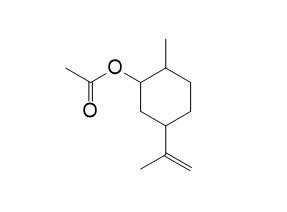(-)-Dihydrocarvyl acetate
Reference standards.
Inquire / Order:
manager@chemfaces.com
Technical Inquiries:
service@chemfaces.com
Tel:
+86-27-84237783
Fax:
+86-27-84254680
Address:
1 Building, No. 83, CheCheng Rd., Wuhan Economic and Technological Development Zone, Wuhan, Hubei 430056, PRC
Providing storage is as stated on the product vial and the vial is kept tightly sealed, the product can be stored for up to
24 months(2-8C).
Wherever possible, you should prepare and use solutions on the same day. However, if you need to make up stock solutions in advance, we recommend that you store the solution as aliquots in tightly sealed vials at -20C. Generally, these will be useable for up to two weeks. Before use, and prior to opening the vial we recommend that you allow your product to equilibrate to room temperature for at least 1 hour.
Need more advice on solubility, usage and handling? Please email to: service@chemfaces.com
The packaging of the product may have turned upside down during transportation, resulting in the natural compounds adhering to the neck or cap of the vial. take the vial out of its packaging and gently shake to let the compounds fall to the bottom of the vial. for liquid products, centrifuge at 200-500 RPM to gather the liquid at the bottom of the vial. try to avoid loss or contamination during handling.
Applied Biological Chemistry2020, 63:33(2020)
APMIS.2019, 127(10):688-695
J Cell Physiol.2020, 10.1002
Environ Toxicol.2023, 38(7):1641-1650.
Antioxidants (Basel).2020, 9(4):326.
Planta Med.2023, a-2192-2281.
Heliyon.2024, 10(23):e40758.
Theoretical and Experimental Plant Physiology 2022, 34,53-62
J Inflamm Res.2022, 15:5347-5359.
Plants (Basel).2024, 13(23):3314.
Related and Featured Products
Nippon Nōgeikagaku Kaishi, 1976,50(6):287-289.
Essential Oil of Mentha spicata L. var. crispa Benth. Grown in Winter Season.[Reference:
WebLink]
The constituents of the essential oil of Mentha spicata L. var. crispa Benth. grown in the winter season were investigated.
METHODS AND RESULTS:
The major components in the oil were detected as (-)-carvone (1), (+)-dihydrocarvone (2), (-)-dihydrocarveol (3), (-)-Dihydrocarvyl acetate (4), (+)-neodihydrocarveol (5) and (-)-cis-carvyl acetate (8). The content of above oxygenated compounds from each oil col-lected in November, December, January and Febrary was showed as follows; 1 (59.1, 40.1, 16.2 and 8.0%), 2 (3.3, 5.8, 3.1 and 3.5%), 3 (6.1, 10.1, 15.7 and 7.8%), 4 (3.8, 10.8, 26.0 and 30.1 %), 5 (5.1, 16.5, 17.4 and 18.5%) and 8 (4.1, 6.4, 9.4 and 14.7%).
CONCLUSIONS:
On the basis of seasonal variation of these components in this species, the following biosynthetic pathways in vivo were postulated: carvone (1) is reduced to afford dihydrocarvone (2). As a next step, 2 thus produced yields dihydrocarveol (3) and neodihydrocarveol (5). The former is further con-verted to its acetate (4) by esterification. While 1 is also converted into cis-carvyl acetate (8) via its alcohol, and a part of 8 proceeds to 4.



